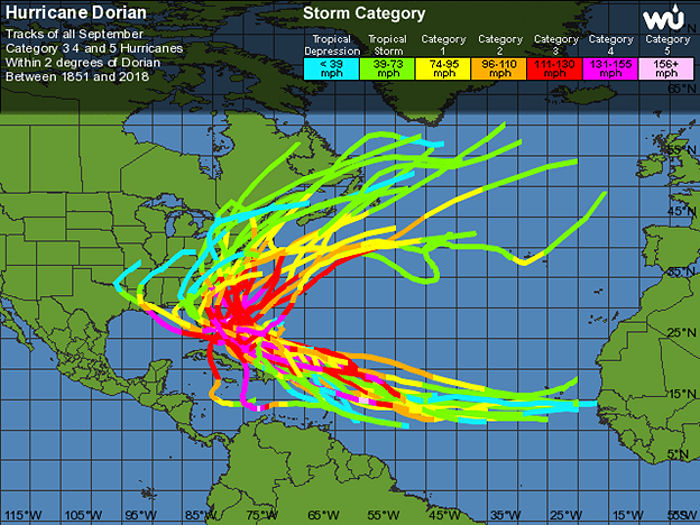Hurricane Dorian
- By:
- Edward A. Reid Jr.
- Posted On:
- Oct 22, 2019 at 6:00 AM
- Category
- Climate Change
The weather system which has developed into Hurricane Dorian was first identified as a tropical depression on August 24th, 2019 approximately three quarters of the way from Guinea-Bissau on the northwest coast of Africa to Venezuela the northeast coast of South America. It was upgraded to a tropical storm later that same day. The system was then upgraded to a hurricane (Cat 1) on August 28th and finally to a Cat 5 hurricane on September 1st.
The weather system has changed direction from West Northwest to Northwest and back to West Northwest. It is currently projected to change direction again to North Northwest, then to North and finally to Northeast over a period of 5 days. These projected changes of path would avoid landfall on the US East coast. The storm is also expected to weaken to Cat 1 over the same period.
Meteorologists do not know why this weather system became a tropical depression at this location at this time. They do not know why it developed into a tropical storm and then into a major hurricane. They do not understand why it is moving very slowly, or why it has made the multiple changes in direction to date, or why it would make the further changes in direction projected for the next several days.
The historical records of the storm tracks of similar hurricanes have not been particularly enlightening for this weather system, as shown below. The computer models have also been of limited value until very recently.
The broadly variant paths of past hurricanes of similar intensity, the significant range of modeled paths for the current system and the inability to predict system intensity suggest the highly questionable nature of computer-based attribution modeling studies used to calculate the affects of climate change on the path, speed and intensity of this and future similar storms.
History tells us that hurricanes will occur in the Atlantic basin, typically beginning in June and extending through November, with the greatest number of hurricanes occurring in September and October. However, the actual events are not predictable as to initiation, location, speed, intensity and likelihood of landfall. This is clearly illustrated by the recent 12-year long absence of land falling strong hurricanes in the US, followed by a very active hurricane season in 2018, neither of which was predicted.
There has been limited recent discussion of possible approaches to weakening hurricanes or causing them to disintegrate to avoid the effects of major landfalling hurricanes. This 60-year old idea has not matured into a successful approach with demonstrated positive results and probably will not due so.
Major hurricanes contain a huge amount of energy and mass, which can do enormous damage in the event of landfall. Hurricanes pre-existed anthropogenic climate change. We have no documented observations that demonstrate that hurricane occurrence or intensity has been affected by climate change, or would be affected by the cessation of climate change. While many have urged application of the Precautionary Principle to our approach climate change, the simple precaution of not building susceptible infrastructure in hurricane-prone areas has been largely ignored.



